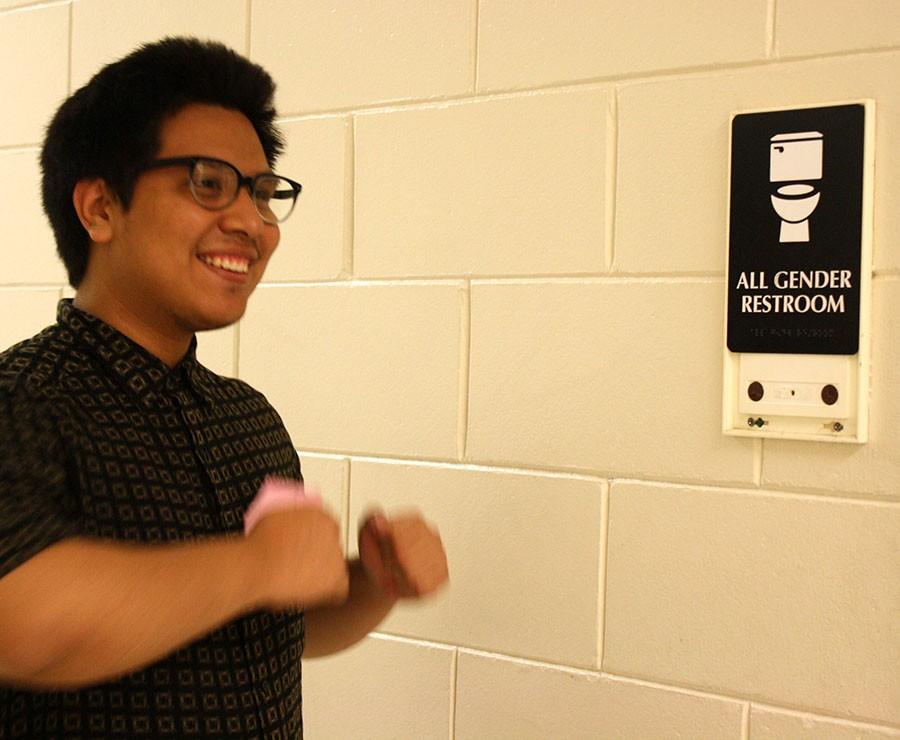The all gender bathroom is not accessible to all students
November 19, 2015
Senior Brandon Castro-Venancio traipses happily into the all gender bathroom, a perfect example of the joy and comfort this resource has the potential to bring.
The All Gender bathroom opened last school year, in April, after a hard fought battle by the Gender Equity Collective and other South students passionate about trans/non-binary liberation. It was implemented after months and months of conceptualization, explanation and conflict with the district, school administration, teachers, and students. It was an important victory for trans and non-binary people who feel unsafe or uncomfortable using gendered facilities.
However, as those who need it start taking use of this new resource, new problems arise. We interviewed four trans/non-binary South students from disparate communities around the school to understand why they use the all gender bathroom, and to suggest steps everyone in our community can take to make it a more accessible place to the people it exists for.
Everyone interviewed spoke passionately about their need for and appreciation of the bathroom. “It’s been nice not having to go to a bathroom that predetermines who you are. You don’t have the pressure of being compulsively gendered,” said senior Brandon Castro-Venancio.
Junior Sophia Wright also talked about the culture of understanding they feel in the all gender bathroom that gendered bathrooms lack. “It feels like a safer place in general. For the most part, everyone in there is aware of the difference between gender and sex, and the problems that can propose. People who don’t know what gender is don’t go to the all gender bathroom, so there’s a feeling of understanding,” Wright said.
However, understanding of what using the all gender bathroom entails can prove problematic to others. “I have never used the all gender bathroom,” said junior Cooper Cooper. “I’m nervous about who might see me using it or walking into it. Using the bathroom seems sort of like an instant ‘coming out’, and since I’m new [to South this year], I’m afraid of what kind of reaction that might get.” Despite this fear, they maintain hope that their hesitations will dissipate. “I’m sure as I become more comfortable at South the bathroom will seem less like an outing and more of a safe place for trans/non-binary people.”
Contributing to that culture of fear is some teachers’ reluctance to acknowledge the bathroom’s existence. Sophomore Renee Smith recalls frequent misgendering when asking teachers for passes. “Teachers’ first instinct is to send you to the bathroom that matches how they see you,” they explained. “It’s weird to have to out yourself to teachers for them to tell you what all your options are.” On the other hand, when teachers remember to include trans and non-binary people’s needs in their daily speech, it can be positive and affirming experience. “Once I asked a teacher where the bathroom was, and they told me where the all gender one is as well,” said Wright. “It’s good that there are teachers that feel comfortable talking about it.”
On top of teachers’ disrespect for the all gender bathroom, trans/non-binary people also have to deal with peers who don’t seem to understand the importance of the space. “It would make me more comfortable if less cis people hung out in there or stopped using it as a place to avoid security guards,” said Cooper. Smith concurred, pointing out “couples making out in there” as one thing that made them less comfortable. Disregard for the space can also contribute to its inaccessibility; in an earlier Southerner article, Principal Aponte cited the need to clean bathrooms of smoke or graffiti as one reason they might be locked.
Regardless of the reason, locking the all gender bathroom can be a big issue. Though Castro-Venancio and Smith reported the bathroom always being open when they’ve wanted to use it, Wright remembered a period earlier this school year where it was closed for two days in a row. “The frustrating thing is that it’s closed so often,” they said, listing numerous instances in which they’ve found the bathroom door locked. “If one of the boys’ or girls’ bathrooms is closed, you can always find another one that’s open. For people who can’t use gendered bathrooms, there’s not really another option.” Wright also expressed worry for others in South’s trans/non-binary community – “What will the consequences be for people who can’t use a gendered bathroom without facing violence? If anyone gets hurt, that’s the administration’s fault.”
In a study done by The Williams Institute, 54% of trans people reported health problems stemming from avoiding public bathroom use. It is becoming increasingly clear that restroom safety for trans and non-binary people is not a laughing matter, nor is it a passing trend. It’s a public health issue, and a human right. Smith put it eloquently when they said “Everyone needs to go to the bathroom, and everyone deserves to be safe doing it.”

Jonathan Boucher • Nov 20, 2015 at 1:06 pm
GREAT article!